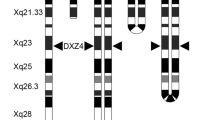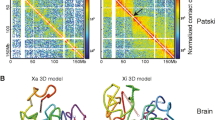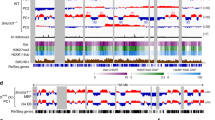Abstract
An idic(Xp-) in which the two X chromosomes are attached short arm to short arm, and which thus has two b regions (the Q-dark segment next to the centromere on Xp) between the inactivation centers, assumed to be situated on the Q-dark region next to the centromere on Xq, showed 63.8% bipartite Barr bodies as compared with 22.2% formed by idic(Xq-). In addition, the mean distance of the two parts of the Barr bodies in the fibroblasts of a patient with idic(Xp-) is significantly greater than in the cases with one or no b region. Contrary to the other patients with abnormal X chromosomes, the buccal cells of a woman idic(Xp-) showed a number of bipartite Barr bodies. — To explain these observations we have put forward the hypothesis that the b region on the Xp always remains active and thus, when the rest of the chromosome forms a Barr body, this segment is extended, allowing the two parts of the X chromatin to get farther apart and at the same time increasing the percentage of bipartite bodies.
Similar content being viewed by others
References
Allderdice, P.W., Miller, O.J., Klinger, H.P., Pallister, P.D., Opitz, J.M.: Demonstration of a spreading effect in an X-autosome translocation by combined autoradiographic and quinacrinefluorescence studies. (Abstr.) Exc. Med. Int. Congr. Ser. 233, 14–15 (1971)
Buckton, K.E., Jacobs, P.A., Rae, L.A., Newton, M.S., Sanger, R.: An inherited X-autosome translocation in man. Ann. hum. Genet. (Lond.) 35, 171–178 (1971)
Chapelle, A. de la, Schröder, J.: Reappraisal of a 46,X, i(Xp) karyotype as 46,Xdel(Xq). Hereditas (Lund) 80, 137–140 (1975)
Chapelle, A. de la, Stenstrand, K.: Dicentric human X chromosomes. Hereditas (Lund) 76, 259–268 (1974)
Daly, R.F., Patau, K., Therman, E., Sarto, G.E.: Structure and Barr body formation of an Xp+ chromosome with two inactivation centers. Amer. J. hum. Genet. 29 (in press 1977)
Darlington, C.D., La Cour, F.L.: The handling of chromosomes. Darien, Conn.: Hafner Publ. Co. 1970
DeMars, R., Nance, W.E.: Electrophoretic variants of glucose-6-phosphate dehydrogenase and the single-active-X in cultivated human cells. Wistar Inst. Symp. Monogr. 1, 35–48 (1964)
Distèche, C., Hagemeijer, A., Frederic, J., Progneaux, D.: An abnormal large human chromosome identified as an end-to-end fusion of two X's by combined results of the new banding techniques and microdensitometry. Clin. Genet. 3, 388–395 (1972)
Gouw, W.L., Coenegracht, J.M., Stalder, G.: A very large metacentric chromosome in a woman with symptoms of Turner's syndrome. Cytogenetics 3, 427–440 (1964)
Lyon, M.F.: Mechanisms and evolutionary origins of variable X-chromosome activity in mammals. Proc. roy. Soc. Lond. B 187, 243–268 (1974)
McKusick, V.A., Chase, G.A.: Human genetics. Ann. Rev. Genet. 7, 435–473 (1973)
Miller, R.: Simultaneous statistical inference. New York: MacGraw Hill 1966
Sarto, G.E., Therman, E., Patau, K.: Increased Q-fluorescence of an inactive Xq- chromosome in man. Clin. Genet. 6, 1–5 (1974)
Takagi, N., Oshimura, M.: Fluorescence and Giemsa banding studies of the allocyclic X chromosome in embryonic and adult mouse cells. Exp. Cell Res. 78, 127–135 (1973)
Therman, E., Patau, K.: Abnormal X chromosomes in man: origin, behavior and effects. Humangenetik 25, 1–16 (1974)
Therman, E., Sarto, G.E., Patau, K.: Center for Barr body condensation on the proximal part of the human Xq: a hypothesis. Chromosoma (Berl.) 44, 361–366 (1974a)
Therman, E., Sarto, G.E., Patau, K.: Apparently isodicentric but functionally monocentric X chromosome in man. Amer. J. hum. Genet. 26, 83–92 (1974b)
Author information
Authors and Affiliations
Rights and permissions
About this article
Cite this article
Therman, E., Sarto, G.E., Distèche, C. et al. A possible active segment on the inactive human X chromosome. Chromosoma 59, 137–145 (1976). https://doi.org/10.1007/BF00328482
Received:
Accepted:
Issue Date:
DOI: https://doi.org/10.1007/BF00328482




